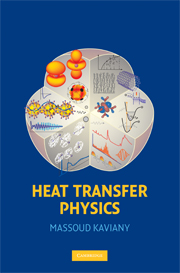Book contents
- Frontmatter
- Contents
- Preface
- Acknowledgments
- 1 Introduction and Preliminaries
- 2 Molecular Orbitals/Potentials/Dynamics, and Quantum Energy States
- 3 Carrier Energy Transport and Transformation Theories
- 4 Phonon Energy Storage, Transport and Transformation Kinetics
- 5 Electron Energy Storage, Transport and Transformation Kinetics
- 6 Fluid Particle Energy Storage, Transport and Transformation Kinetics
- 7 Photon Energy Storage, Transport and Transformation Kinetics
- APPENDIX A Tables of Properties and Universal Constants
- APPENDIX B Derivation of Green–Kubo Relation
- APPENDIX C Derivation of Minimum Phonon Conductivity Relations
- APPENDIX D Derivation of Phonon Boundary Resistance
- APPENDIX E Derivation of Fermi Golden Rule
- APPENDIX F Derivation of Equilibrium, Particle Probability Distribution Functions
- Nomenclature
- Abbreviations
- Glossary
- Bibliography
- Index
APPENDIX F - Derivation of Equilibrium, Particle Probability Distribution Functions
Published online by Cambridge University Press: 06 July 2010
- Frontmatter
- Contents
- Preface
- Acknowledgments
- 1 Introduction and Preliminaries
- 2 Molecular Orbitals/Potentials/Dynamics, and Quantum Energy States
- 3 Carrier Energy Transport and Transformation Theories
- 4 Phonon Energy Storage, Transport and Transformation Kinetics
- 5 Electron Energy Storage, Transport and Transformation Kinetics
- 6 Fluid Particle Energy Storage, Transport and Transformation Kinetics
- 7 Photon Energy Storage, Transport and Transformation Kinetics
- APPENDIX A Tables of Properties and Universal Constants
- APPENDIX B Derivation of Green–Kubo Relation
- APPENDIX C Derivation of Minimum Phonon Conductivity Relations
- APPENDIX D Derivation of Phonon Boundary Resistance
- APPENDIX E Derivation of Fermi Golden Rule
- APPENDIX F Derivation of Equilibrium, Particle Probability Distribution Functions
- Nomenclature
- Abbreviations
- Glossary
- Bibliography
- Index
Summary
The Fermi-Dirac (fermion) and Bose-Einstein (boson) statistics include quantum effects and apply to interacting, indistinguishable particles (Table 1.2). The M- B statistics apply to noninteracting indistinguishable particles (classical particles), whose wave functions do not overlap and quantum effects vanish (footnote of Section 2.6.5). When the particle concentration is much less than the quantum limit, quantum effects will vanish and all the particles can be treated as classical particles. The ratio of the particle concentration and the quantum limit is called the quantum concentration (footnote of Section) nq, which is defined by
where N is the number of particles, V is the volume of the system, m is the mass of the particle, and T is the temperature. Therefore both fermions and bosons become the M-B statistics at high temperatures or low concentrations.
Derivation of the particle (including quantum) statistics distribution functions are given in [119, 239].
Partition Functions
For different ensembles [Section 2.5.1(A)], the partition function may have different forms. For a canonical ensemble, the partition function (2.27) is defined as
where j designates the energy state of the system.
For a grand canonical ensemble (μ VT), the partition function is defined as
where N is the number of particles, and when it is a constant, then μ = 0, and Z(μ, V, T)becomes Z(N, V, T), relating (F.2) and (F.3).
- Type
- Chapter
- Information
- Heat Transfer Physics , pp. 614 - 618Publisher: Cambridge University PressPrint publication year: 2008



